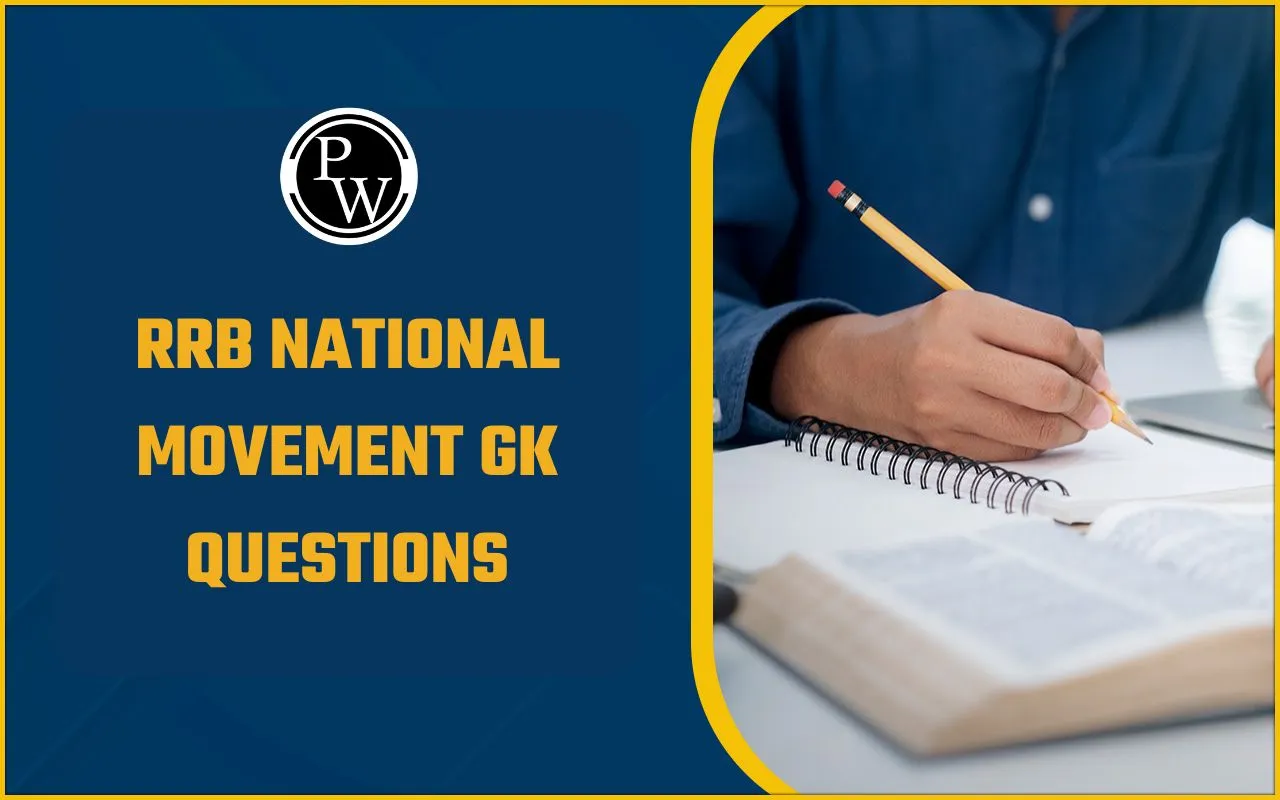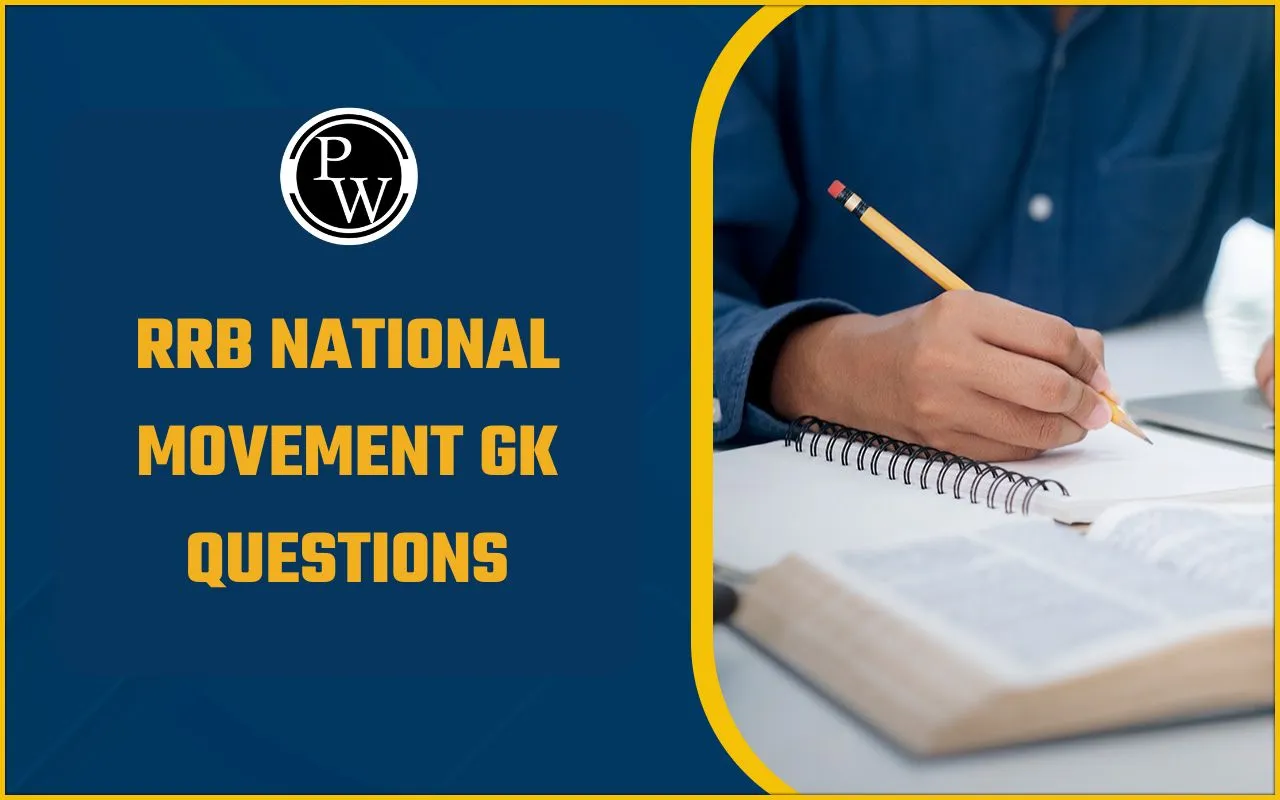

RRB National Movement GK Questions test candidates’ factual knowledge, analytical ability, and the capacity to connect historical events with their impact on India’s path to independence. These questions focus on important events, key leaders, significant acts, and major movements such as the Revolt of 1857, Non-Cooperation Movement, Civil Disobedience, and Quit India Movement.
Consistent practice of RRB National Movement GK previous years’ questions and mock tests helps aspirants strengthen their knowledge and improve accuracy in the exam.
RRB National Movement GK Questions PDF
Candidates preparing for RRB exams can also download the RRB National Movement GK Questions PDF from the provided links. This PDF includes a wide range of important General Knowledge questions related to India's freedom struggle, covering key events, movements, leaders, and milestones in the National Movement.
Along with factual knowledge, the PDF helps improve skills in quick recall, analytical thinking, and exam-oriented preparation strategy. Regular practice with such PDFs enables aspirants to score well in the General Awareness section of RRB NTPC, RRB Group D, and RRB ALP exams.
Download English and Hindi RRB NTPC National Movement GK questions from below:
| RRB National Movement GK Questions PDF | |
| RRB National Movement GK Questions PDF in English | |
| RRB National Movement GK Questions PDF in Hindi | |
RRB GK Tricks for Quick Revision
GK is a significant part of the RRB NTPC, Group D, ALP, and JE exams. Knowing certain tricks and tips can significantly boost your accuracy and speed in the General Awareness section. These will help you to remember crucial facts, dates, and events from India’s history, geography, and national movements through mnemonics, mind maps, and association techniques.
Given below are some RRB GK Tricks for quick revision to recall factual data for the exam:
| RRB GK Tricks for Quick Revision | |
| Particulars | Quick Tricks / Methods |
| Current Affairs | Revise last 6 months of national and international news through monthly PDFs and daily RRB Indian National Movement GK quiz. |
| Indian Polity | Use acronyms to memorize Parts, Articles, and Schedules (e.g., PAF for Part, Article, Fundamental Rights). |
| Indian History (National Movement) | Create timelines and keyword charts for the Revolt of 1857, the Gandhian movements, and key leaders. |
| Geography | Use mapping visualization. Relate rivers, capitals, and mountain ranges to states. |
| Economy & Budget | Focus on recurring terms like GDP, inflation, fiscal deficit. Revise Budget highlights before the exam. |
| General Science | Summarize Physics, Chemistry, and Biology formulas and discoveries in short notes. |
| Static GK | Memorize important national parks, lakes, and organizations using mnemonics (e.g., “KNP” for Kaziranga, Nameri, and Pobitora in Assam). |
| Books & Authors | Group authors by themes, freedom struggle, fiction, and political works. |
| Awards & Personalities | Track recent Padma awards, Bharat Ratna recipients, and Nobel winners annually. |
| Mock Practice | Attempt topic-based mock tests and analyze mistakes weekly. |
RRB National Movement GK Questions
RRB National Movement GK Questions focus on assessing a candidate's knowledge of India's freedom struggle and historical events. The GK syllabus includes significant acts and reforms introduced by the British, along with awareness of key historical sessions of the Indian National Congress.
Preparing these questions involves understanding the chronological order of events, key personalities, their contributions, and the impact of various movements on Indian independence.
Here are some Indian National Movement GK Questions for RRB:
1.Who was the first Muslim President of the Indian National Congress?
(A) Abu Kalam Azad
(B) Badruddin Tyabji
(C) Nawab Syed Muhammad Bahadur
(D) Dada Bhai Naoroji
2. Who led the Indian National Congress at its first annual session?
(A) Surendra Nath Banerjee
(B) Dadabhai Naoroji
(C) WC Banerjee
(D) AO Hume
3. Who among the following are the moderate leaders?
(A) Dadabhai Naoroji
(B) W.C.Banerjee
(C) R.C.Dutt
(D) All of the above
4. Who founded the Indian National Congress?
(A) A.O. Hume
(B) Dadabhai Naoroji
(C) Surendranath Banerjee
(D) Dinshaw Wacha
(A) December, 1885
(B) November, 1906
(C) January, 1884
6. The first session of the Indian National Congress was held at
(A) Bombay
(B) Madras
(C) Calcutta
(D) Surat
7. Which trio of leaders had extremist outlooks and were known as Lal-Bal-Pal?
(A) Mahatma Gandhi, Jawaharlal Nehru, Subhas Chandra Bose
(B) Bal Gangadhar Tilak, Lala Lajpat Rai, Bipin Chandra Pal
(C) Dadabhai Naoroji, Gopal Krishna Gokhale, Surendranath Banerjee
(D) Rajagopalachari, Motilal Nehru, Vallabhbhai Patel
8. Who among the following was the prominent leader of the Moderate Phase of the Indian National Congress?
(A) Mahatma Gandhi
(B) Bal Gangadhar Tilak
(C) Gopal Krishna Gokhale
(D) Jawaharlal Nehru
9. What were the main objectives of the extremist phase of the Indian National Congress? (A) Gradual political reforms and constitutional methods
(B) Collaboration with the British government
(C) Immediate self-rule and complete independence
(D) Preservation of British colonial rule
(A) Banaras Hindu University
(B) Calcutta
12.Which of the following parties supported the move for partition of Bengal?
(A) Gadar Party
(B) Forward Bloc
(C) All India Muslim League
(D) Communist party of India
13. The Swadeshi Movement during the Indian freedom struggle encouraged Indians to:
(A) Boycott foreign goods
(B) Promote communal harmony
(C) Support British rule
(D) Embrace the Western culture
14. The Swadeshi Movement was closely associated with which other movement in India?
(A) Champaran Movement
(B) Civil Disobedience Movement
(C) Non-Cooperation Movement
(D) Quit India Movement
15. The method used by the extremists to achieve independence was?
(A) Swadeshi method
(B) Boycott method
(C) Both A and B
(D) None of the above methods
16. When was India's capital shifted from Calcutta to Delhi?
(A) 1911
(B) 1905
(C) 1910
(D) 1912
17. In the Lahore conspiracy case, which leaders were held guilty?
(A) Bhagat Singh
(B) Sukhdev
(C) Rajguru
(D) All of the above
18. On 8th April 1929, who among the following two revolutionists threw a bomb in the Central Legislative Assembly?
(A) Bhagat Singh and Rajguru
(B) Bhagat Singh and Ram Prasad Bismil
(C) Bhagat Singh and Batukeshwar Dutt
(D) Bhagat Singh and Sukhdev
19. Bhagat Singh was executed on March 23, 1931 along with ___
(A) B.K. Dutt and Rajguru
(B) Sukhdev and Chandra Shekhar Azad
(C) Sukhdev and B.K. Dutt
(D) Sukhdev and Rajguru
20. In which year did Lala Hardayal form the Gadar Party?
(A) 1885
(B) 1897
(C) 1905
(D) 1913
Benefits of Solving RRB National Movement GK Questions
Practicing RRB National Movement GK Questions regularly helps candidates strengthen their understanding of India’s freedom struggle and its key milestones. Regular practice enhances factual recall, improves historical perspective, and builds confidence to tackle both static and analytical GK questions in the RRB NTPC and Group D exams.
- Here are some key benefits of solving RRB National Movement GK Questions from PDF practice sets:
- Practicing RRB National Movement GK Questions regularly provides candidates with structured exposure to important topics from India’s freedom struggle, enhancing their readiness for the General Awareness section of RRB exams.
- Through previous year questions and model papers, aspirants familiarize themselves with common question patterns, difficulty levels, and frequently asked topics.
- Regular practice of questions from the RRB Group D national movement GK PDF not only improves recall speed and accuracy but also helps identify weaker areas for focused revision.
- Additionally, candidates can participate in various quizzes and tests to evaluate their knowledge. This will help them tackle the Indian National Movement Objective GK for the Railway exam effectively.
